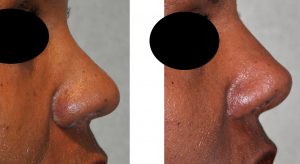Changing the shape of the nose through rhinoplasty surgery continues to be increasingly popular amongst African-Americans. The most common reasons sought for nasal improvement are lack of tip definition, wide nostrils, flat bridge of the nose and breathing problems. The consistent theme is that the nose is broad and lacks a well-defined bridge and tip. The nose simply does not fit well with the overall shape of their face.
Every African-American is sensitized to the ‘Michael Jackson look’ and that, of course, is not the goal. In any non-Caucasian rhinoplasty, everyone knows that the goal is to maintain ethnicity. Moderate shape improvement is always better tolerated than an unnatural look which comes from trying to make the rhinoplasty do ‘too much’. The thick skin, short nasal bones, and broad tips of the African-American nose require special handling and an appreciation that you can’t and shouldn’t try and make a thick broad nose into a thin delicately shaped one.

The skin in every rhinoplasty patient is more than just an obstacle in the way of the surgery. How the skin reacts as it heals long after the surgery is a key factor in how definition of the nasal tip is or is not seen. The thickness of African-American skin on the tip of the nose means it usually must be thinned but supported as it contracts during healing. Debulking of fat underneath the skin, leaving just a thin layer on the underside of the dermis, is needed to improve definition. But the widely spaced tip cartilages must be supported by cartilage grafts to the columella and tip to give the thinned tip skin a stable structure to heal and contract on for better shape and definition.
Next to tip refinement, definition of the dorsum is the most requested nasal change in this ethnic group. How to do that is controversial. The simplest and very effective method is to use an implant which is usually made from silicone. This builds up the dorsal line quickly and significantly. Because of infection and long-term risks of extrusion, however, the use of one’s own tissue is preferred by many. Your own cartilage has no rejection or significant infection risks but such grafts are less effective in building up the bridge and does require a donor harvest. Typically, this tissue is taken from the septum or the ear but this is often not enough for a real visible bridge change. The use of a rib graft gets around that issue.
The short and wide nasal bones can be narrowed but that must be done carefully. And it always needs to be done with bridge augmentation to get the overall look of a more narrow and refined upper third of the nose.
Nostril narrowing is a key maneuver. It can be done through skin removal in the alar crease or from inside the nostril sill. More effective nostril changes comes from the external incision approach but such scars for me are to be avoided. Keeping the scar inside the nostril may not make as much of a change but the potential scar issues are less and more easily improveable should they turn out to be a problem.
Dr. Barry Eppley
Indianapolis, Indiana


